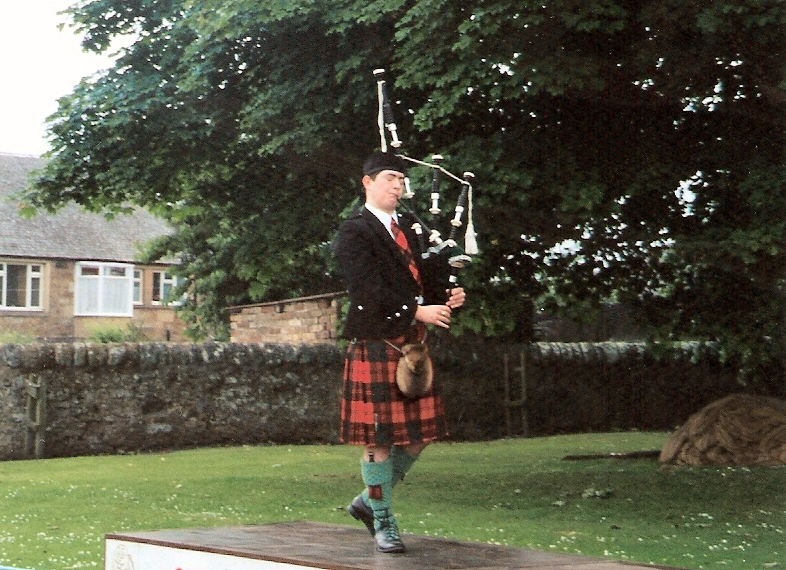
There's very little going on other than the tug of war competition when we first arrive, though announcements are made continuously over the public address system. I had expected a lot of crafts and clan tents but this is more like a flea market. The food stalls offer carnival food; hot dogs and hamburgers. The carnival atmosphere is reinforced by rides booming and thumping out modern rock music on the far side of the competitors' arena.
As unremarkable as it seems on the surface, there is something enthralling about being a part of this annual small-town event. We stop and watch the piping competition for a while, something that is obviously taken very seriously. The two judges have pensive, but attentive, expressions on their faces as the participant in the solo piping contest paces slowly back and forth on a platform.
We make another complete circuit, laughing as the master of ceremonies announces that the sun is under contract to appear at 1:30. It seems very unlikely; the clouds are thick and threatening, the wind very brisk and cutting. Wandering through the crowd, I realize that even though I'm 3,000 miles from home on a trip of a lifetime – in Scotland, as I've dreamed of for so many years – the people in Cupar are just like people in any small town anywhere; teenagers climb over the fence to avoid paying the admission fee, firefighters hoist small children up into the seat of their fire engine, mothers beam with pride as their children complete their round of competition at dance. And then through the crowd comes a rugged Highlander – a man attired as though time has forgotten him in kilt, bonnet and boots. The only thing missing is a claymore strapped to his back. I'm glad to see that even the locals turn their heads to stare. He is quite impressive.
The tug of war has drawn our attention and we stand at the edge of the arena watching. Dana and I get the giggles as one lad reaches up under his shorts to pull down his jersey, exposing a little more flesh than perhaps he thought he may have been exposing. We get a little bawdy, then a little giddy and Robin breaks out the video camera, zooming in on his "pockets". In retrospect I think we may have made a spectacle of ourselves. But as Penny said later when we told her about this, he had to have known that he would, and possibly meant to, draw attention to himself by wearing such short shorts. (They were very short.)
An announcement is made that the dog show will be taking place soon – a dog show the likes of which I've never seen before. I had expected to see border collies put through their paces but the categories in this show include biggest dog, kindest eyes, and longest tail. But it's being held behind a barricade that there seems to be no way around, other than leaving the area and finding another entrance. It's not important enough to seek out. We've certainly seen our share of huge dogs leading their owners through the crowd, some of which are wearing bibs to catch big dog drool.
The master of ceremonies has asked that people from other places come to the dais to introduce themselves and soon people from New Zealand, Germany, Chile, and Seattle are at the microphone. As we stand continuing to enjoy watching the tug of war competition, which is reminding me more and more of college fraternity rivalries with the lads in their brightly colored jerseys and shorts, the heavy sports competitors arrive. Here are several braw lads in kilts, one of whom I mentally dub Bubba Hamish. He's ruddy complexioned with straw-colored hair and dressed in a Guinness Stout tee-shirt and kilt with bicycle shorts beneath. I can easily imagine this lad working a farm nearby, tossing huge bales of hay as if they weigh no more than a feather.

Cupar is a town, former royal burgh and parish in Fife, Scotland. It lies between Dundee and Glenrothes. The town is believed to have grown around the site of Cupar Castle, which was the seat of the sheriff and was owned by the earls of Fife. The area became a center for judiciary as the county of Fife and as a market town catering for both cattle and sheep.
Towards the latter stages of the 13th century, the burgh became the site of an assembly of the three estates - clergy, nobility and burgesses - organised by Alexander III in 1276 as a predecessor of the Parliament of Scotland. Although written information of a charter for the modern town was lost, evidence suggested that this existed as one of the many properties owned by the Earls of Fife by 1294.
Read more about Cupar on Wikipedia.